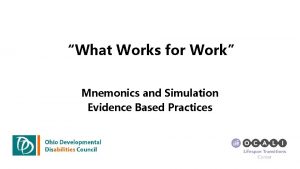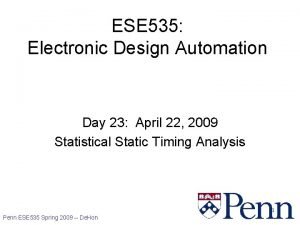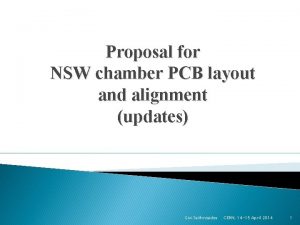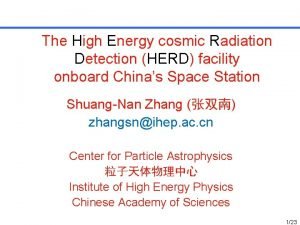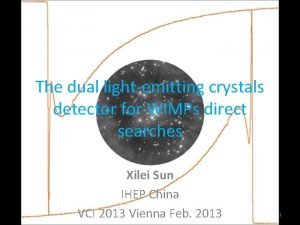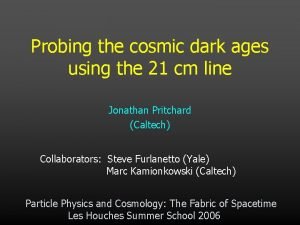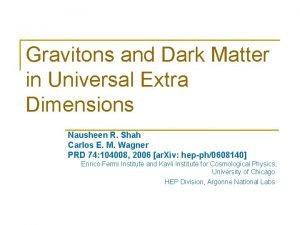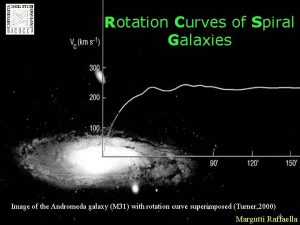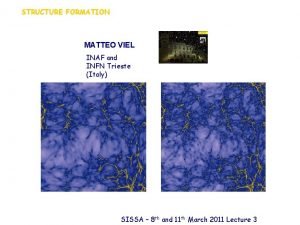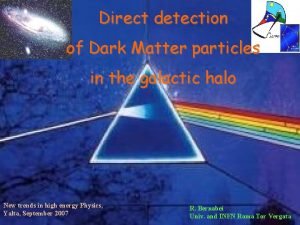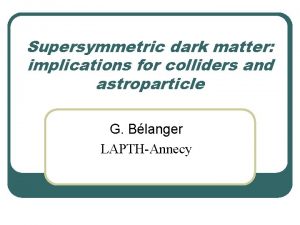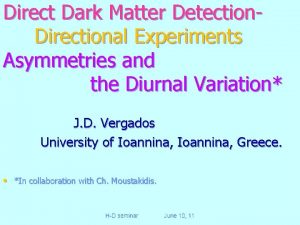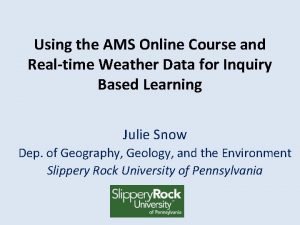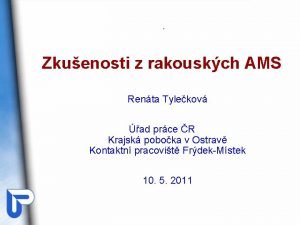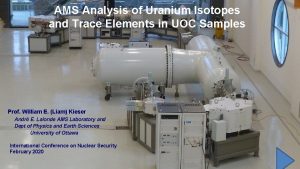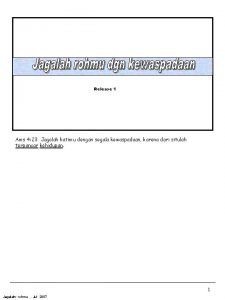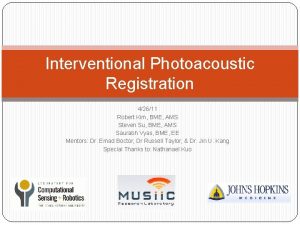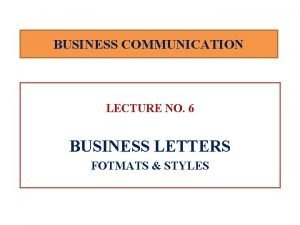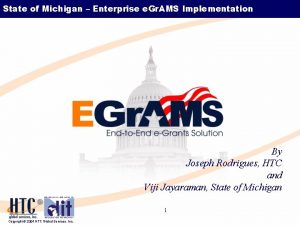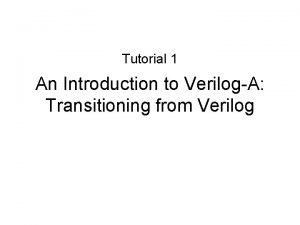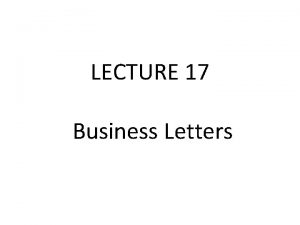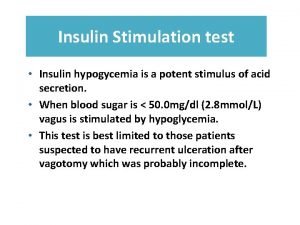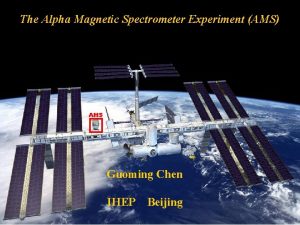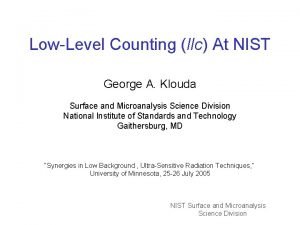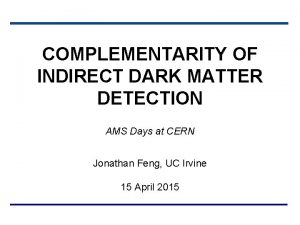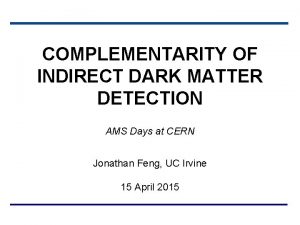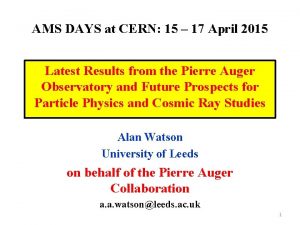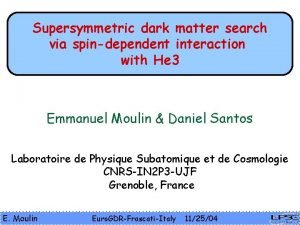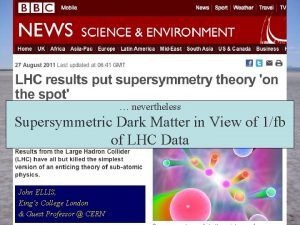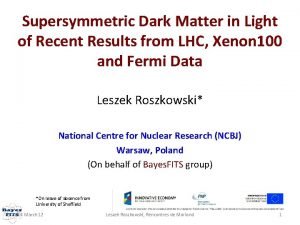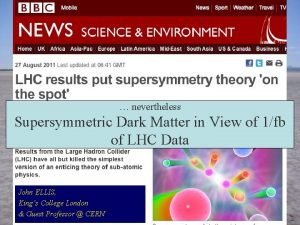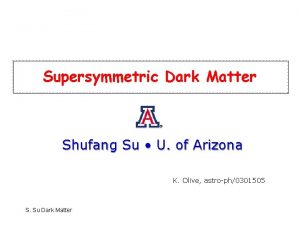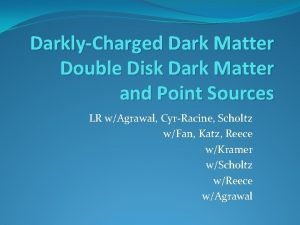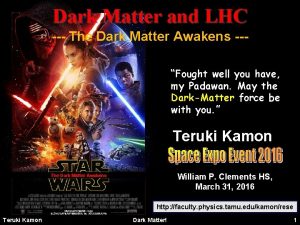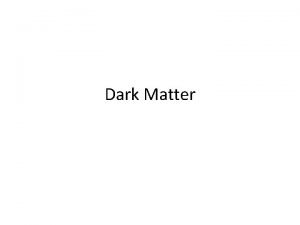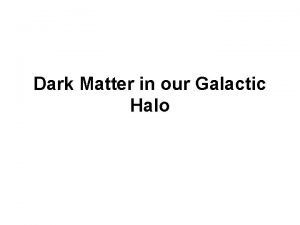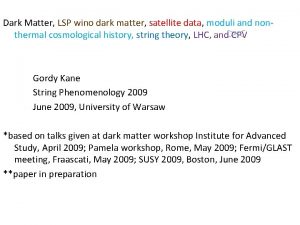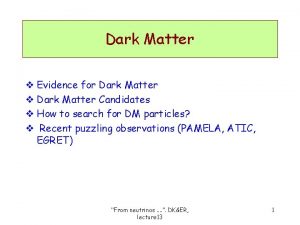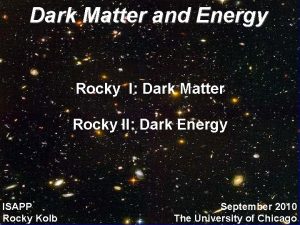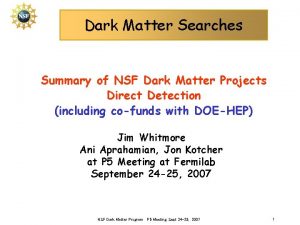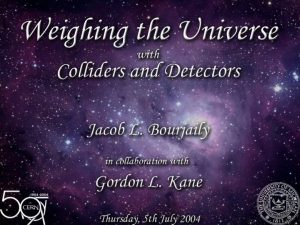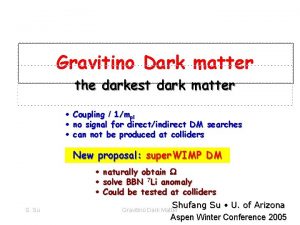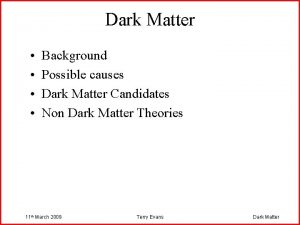Supersymmetric Dark Matter AMS days at CERN April














































- Slides: 46

Supersymmetric Dark Matter AMS days at CERN April 15 – 17, 2015 Dark Energy Survey John Ellis King’s College London & CERN

What lies beyond the Standard Model? Supersymmetry New motivations From LHC Run 1 • Stabilize electroweak vacuum • Successful prediction for Higgs mass – Should be < 130 Ge. V in simple models • Successful predictions for couplings – Should be within few % of SM values • Naturalness, GUTs, string, …, dark matter

Why Supersymmetry (Susy)? • Hierarchy problem: why is m. W << m. P ? (m. P ~ 1019 Ge. V is scale of gravity) • Alternatively, why is GF = 1/ m. W 2 >> GN = 1/m. P 2 ? • Or, why is VCoulomb >> VNewton ? e 2 >> G m 2 = m 2 / m. P 2 • Set by hand? What about loop corrections? δm. H, W 2 = O(α/π) Λ 2 • Cancel boson loops fermions • Need | m. B 2 – m. F 2| < 1 Te. V 2

Minimal Supersymmetric Extension of Standard Model (MSSM) • Double up the known particles: • Two Higgs doublets - 5 physical Higgs bosons: - 3 neutral, 2 charged • Lightest neutral supersymmetric Higgs looks like the single Higgs in the Standard Model

Lightest Supersymmetric Particle • Stable in many models because of conservation of R parity: R = (-1) 2 S –L + 3 B where S = spin, L = lepton #, B = baryon # • Particles have R = +1, sparticles R = -1: Sparticles produced in pairs Heavier sparticles lighter sparticles • Lightest supersymmetric particle (LSP) stable


LSP as Dark Matter? • No strong or electromagnetic interactions Otherwise would bind to matter Detectable as anomalous heavy nucleus • Possible weakly-interacting scandidates Sneutrino (Excluded by LEP, direct searches) Lightest neutralino χ (partner of Z, H, γ) Gravitino (nightmare for detection)

Supersymmetric Signature @ LHC Missing transverse energy carried away by dark matter particles

Sample Supersymmetric Models • Universal soft supersymmetry breaking at input GUT scale? – For gauginos and all scalars: CMSSM – Non-universal Higgs masses: NUHM 1, 2 • Strong pressure from LHC (p ~ 0. 1) • Treat soft supersymmetry-breaking masses as phenomenological inputs at EW scale – p. MSSMn (n parameters) – With universality motivated by upper limits on flavour-changing neutral interactions: p. MSSM 10 • Less strongly constrained by LHC (p ~ 0. 3)

Fit to Constrained MSSM (CMSSM) 2012 20/fb Buchmueller, JE et al: ar. Xiv: 1312. 5250 p-value of simple models ~ 10% (also SM)

Fits to Supersymmetric Models 20121 520/fb Squark mass Reach of LHC at High luminosity De Vries, JE et al: ar. Xiv: 1504. 03260 Favoured values of squark mass significantly above pre-LHC, > 1. 5 Te. V

Fits to Supersymmetric Models 20121 520/fb Gluino mass Reach of LHC at High luminosity De Vries, JE et al: ar. Xiv: 1504. 03260 Favoured values of gluino mass also significantly above pre-LHC, > 1. 2 Te. V

Fits to Supersymmetric Models 20121 Stop mass 520/fb Compressed stop region De Vries, JE et al: ar. Xiv: 1504. 03260 Remaining possibility of a light “natural” stop weighing ~ 400 Ge. V

Exploring Light Stops @ Run 2 20121 p. MSSM 10 520/fb Reach of chargino + b searches Reach of LSP + top searches De Vries, JE et al: ar. Xiv: 1504. 03260 Part of region of light “natural” stop weighing ~ 400 Ge. V can be covered

Anomalous Magnetic Moment of Muon 20121 520/fb gμ – 2 anomaly Can be explained in p. MSSM 10 Cannot be explained by models with GUT-scale unification De Vries, JE et al: ar. Xiv: 1504. 03260 p. MSSM 10 can explain experimental measurements of gμ - 2

Possible Dark Matter Particle Mass 20121 520/fb Neutralino mass Too heavy to explain Ge. V γ excess? De Vries, JE et al: ar. Xiv: 1504. 03260 p. MSSM 10 favours smaller masses than in models with GUT-scale unification

Where May CMSSM be Hiding? Relic density constraint, assuming neutralino LSP Stau coannihilation strip HE-LHC Stop coannihilation/ focus-point strip Excluded because stau or stop LSP Excluded by ATLAS Jest + MET search Excluded by b s γ, Bs μ+μJE, Olive & Zheng: ar. Xiv: 1404. 5571 LHC 3000 LHC 300

Exploring the Stop Coannihilation Strip LHC 8 Te. V LHC 300 (monojets), MET HE-LHC (monojets), MET 100 Te. V (monojets), MET LHC 3000 (monojets), MET • Compatible with LHC measurement of mh • May extend to mχ = mstop ~ 6500 Ge. V JE, Olive & Zheng: ar. Xiv: 1404. 5571

Future Circular Colliders The vision: explore 10 Te. V scale directly (100 Te. V pp) + indirectly (e+e-)

Reaches for Sparticles LHC: HE-LHC, FCC-hh

Squark-Gluino Plane Discover 12 Te. V squark, 16 Te. V gluino @ 5σ

Reach for the Stop × possible tip of stop coannihilation strip Discover 6. 5 Te. V stop @ 5σ, exclude 8 Te. V @ 95% Stop mass up to 6. 5 Te. V possible along coannihilation strip

How Heavy could Dark Matter be in p. MSSM? • Largest possible mass in p. MSSM is along gluino coannihilation strip: mgluino ~ mneutralino Nominal calculation Cosmological dark matter density • Extends to mχ = mgluino ~ 8 Te. V JE, Luo & Olive: ar. Xiv: 1504. 07142

Reaches for Sparticles Model with compressed spectrum: small gluinoneutralino mass difference Large mass possible in gluino coannihilation scenario for dark matter

Direct Dark Matter Searches • Compilation of present and future sensitivities Neutrino “floor”

Direct Dark Matter Search: p. MSSM 10 20121 520/fb Spin-independent dark matter scattering May also be below Neutrino ‘floor’ De Vries, JE et al: ar. Xiv: 1504. 03260 Direct scattering cross-section may be very close to LUX upper limit, accessible to LZ experiment

LHC vs Dark Matter Searches • Compilation of present “mono-jet” sensitivities • LHC wins for spin-independent, except small m. DM Buchmueller, Dolan, Malik & Mc. Cabe: ar. Xiv: 1407. 8257; Malik, Mc. Cabe, …, JE et al: ar. Xiv: 1409. 4075

Projections for Future • Via searches for “mono-jets” • Vector interaction • Sensitive to mediator mass Buchmueller, Dolan, Malik & Mc. Cabe: ar. Xiv: 1407. 8257; Malik, Mc. Cabe, …, JE et al: ar. Xiv: 1409. 4075

BUT, does this have any relevance to AMS?

Positron Fraction Rising (? ) with E Dark Matter? Galactic cosmic rays? Local sources?

Sum of Electron + Positron Spectra Dark Matter? Galactic cosmic rays? Local sources?

AMS Fit with 2 -Component Model Could be galactic cosmic rays + local sources?

Galactic Cosmic Rays Alone? Blum, Katz& Waxman, ar. Xiv: 1305. 1324 Rising positron fraction compatible with model-independent bound on secondary e+

Dark Matter Fits to AMS Positron Data JE, Olive & Spanos, in preparation Fit with modified GALPROP parameters

Quality of Fit with τ+τ- Spanos, ar. Xiv: i 1312. 7841 Good fit with modified GALPROP parameters

Fits with Different Final States JE, Olive & Spanos, in preparation Best fit with τ+τ-: μ+μ- next best

BUT The required annihilation crosssection is VERY large

τ+τ- Fit needs Large Annihilation Rate Need cross-section near unitarity limit unless big clumping enhancement Planck Collaboration JE, Olive & Spanos, in preparation Requires rate above thermal relic value, limits from dwarf spheroidal galaxies, Planck

Potential impact of new AMS Data Harder p spectrum favours flatter antiproton fraction Will revolutionize calculations of cosmic-ray backgrounds

Assume Local Source: Constrain any extra Dark Matter Contribution Dark Matter annihilation could give feature above otherwise smooth distribution Bergstrom et al, ar. Xiv: : 1306. 3983

Previous Antiproton/Proton Ratio With previous estimate of secondary production

New Antiproton/Proton Ratio Above previous estimate of secondary production

Antiproton/Proton Ratio Blum, Katz & Waxman: ar. Xiv: 1305. 1324 JE, Olive & Spanos, in preparation GALPROP can give ~ constant ratio > 150 Ge. V

Antiproton/Proton Ratio Giesen et al, ar. Xiv: 1504. 04274 Secondary production compatible with AMS-02

Summary • Rumours of the death of SUSY are exaggerated – Still the best framework for Te. V-scale physics • Still the best candidate for cold dark matter • Simple models (CMSSM, etc. ) under pressure – More general models quite healthy • Good prospects for LHC Run 2 and for direct dark matter detection – But no guarantees • No smoking “gunino” yet from AMS

Does Dark Matter Self-Interact? Displacement between galaxy and lensing mass in Abel 3827 Would need mediator mass in Me. V range
 Dark matter and dark energy presentation
Dark matter and dark energy presentation 30 days has september april june and november
30 days has september april june and november 535 days before 23 april
535 days before 23 april Cern april fools proposal for space
Cern april fools proposal for space In the dark dark town
In the dark dark town Calo
Calo Dark matter
Dark matter Les houches dark matter
Les houches dark matter Matter gravitons dimensions
Matter gravitons dimensions Dark matter physics
Dark matter physics Dark matter
Dark matter Boosted dark matter
Boosted dark matter Where to stream dark matter
Where to stream dark matter Dark matter
Dark matter Dark matter
Dark matter What could dark matter be
What could dark matter be Classification of matter section 1 composition of matter
Classification of matter section 1 composition of matter Gray matter and white matter
Gray matter and white matter Chapter 2 section 1 classifying matter answers
Chapter 2 section 1 classifying matter answers What does grey matter do
What does grey matter do Classification of matter section 1 composition of matter
Classification of matter section 1 composition of matter Arbor vitae
Arbor vitae Energy naturally flows from warmer matter to cooler matter.
Energy naturally flows from warmer matter to cooler matter. Grey vs white matter
Grey vs white matter Section 1 composition of matter
Section 1 composition of matter Ams realtime weather maps central
Ams realtime weather maps central Ams hollabrunn
Ams hollabrunn Ams material
Ams material Ams 4:23
Ams 4:23 Ams.l
Ams.l Pyelostomi nefrostomi
Pyelostomi nefrostomi Bme: ams
Bme: ams Ams mdm gujarat gov in
Ams mdm gujarat gov in Fotmats
Fotmats Wida screener writing scoring rubric
Wida screener writing scoring rubric I ams
I ams Ams designer
Ams designer Transition veriloga
Transition veriloga Ams simplified letter format
Ams simplified letter format Hitachi ams 2100
Hitachi ams 2100 My unt login
My unt login Ams pancreas
Ams pancreas Ams
Ams Anna triveni yojana
Anna triveni yojana Uci timesheet
Uci timesheet The role of internet exchanges and peering
The role of internet exchanges and peering Ams csru
Ams csru

